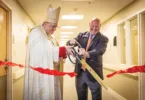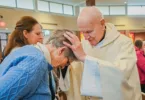
Outgoing HR head Kathleen Thomas is winding up her final days in the chancery. Thomas will mentor Michele Kooiman, the new director of human resources for the archdiocese, until the end of July. LEAVEN PHOTO BY JOE BOLLIG
By Joe Bollig
joe.bollig@theleaven.org
KANSAS CITY, Kan. — “So, what are you looking for in your ideal candidate?” one candidate asked.
“We already have our ideal candidate,” quipped vicar general Father Gary Pennings. “It’s our current occupant in the position.”
It’s impossible to overstate the impact Kathleen Thomas, who is now retiring, has had on the administration of the Archdiocese of Kansas City in Kansas during her 10-year tenure as director of human resources, said colleagues.
“She took the archdiocese out of the ‘stacks and stacks of paper world,’ and into process automation through technology,” said Carla Mills, chief financial officer for the archdiocese. “That enabled us to offer more and better benefits to the employees of the archdiocese.”
But it wasn’t just new technology that Thomas brought to the human resources office. She also brought professionalism, warmth, humanity, idealism, competence and a strong faith.
Although she officially stepped down in April, Thomas stayed on as “human resources emeritus” to assist her successor, Michele Kooiman. Thomas’ last day is at the end of July.
She has left some big shoes to fill.
Challenges and accomplishments
It’s probably safe to say that one of the least glamorous and unheralded departments of any large organization is human resources.
And yet, it’s also the most necessary.
Under the umbrella of human resources falls labor law compliance, personnel policies and procedures, hiring and firing, conflict resolution, payroll and benefits.
People tend to take the work of human resources for granted — until they need it.
“Accounting and human resources are like sausage makers,” said Mills. “Nobody wants to know where it comes from. Nobody cares how it’s made. Nobody understands. They just want it to look nice and come out good in the end.”
Prior to Thomas coming to the archdiocese in July 2008, human resources functions were split between two chancery offices: insurance and other employee benefits, and administrative services.
Her first accomplishment was uniting those two functions in a new, dedicated human resources office.
The next accomplishment was extending human resources services to the entire archdiocesan administrative structure.
“When I came on,” said Thomas, “part of the services that the archdiocese was contracting to provide was HR consulting.”
Now that is provided from the church offices.
A third challenge that Thomas faced right away was streamlining benefit processing for all the archdiocesan entities.
Before Thomas, every parish, school and entity had a different payroll system and cycle. It was like having a marching band with players stepping at different paces and playing music at different tempos.
Thomas also standardized benefit enrollment processing for all parishes and institutions of the archdiocese by utilizing an online enrollment and billing system called HBC.
This, her fourth big accomplishment, was the first technology upgrade by the archdiocese for administering benefits more effectively in a multi-employer environment.
And then came another challenge just as big and complex.
It was decided by the archdiocesan administration to freeze the then-existing archdiocesan pension plan for lay employees and replace it with a 401(k) retirement plan.
“Carla Mills, Kathleen Thomas and I had to travel the archdiocese [to explain it],” said accounting director Beth Coleman, in what is fondly remembered as the “401(k) Road Tour.”
“This change, as well as the reporting requirements imposed by the Affordable Care Act, required the collection of data, making payroll standardization and integration throughout the archdiocesan entities inevitably necessary,” said Thomas. “A more robust and integrated software option needed to be found.”
So, in April 2017, the phased implementation of a new, integrated software called Dayforce by Ceridian began. It will be fully implemented by January 2019.
Finally, some parts of the ACA conflicted with church teaching, so Thomas had to carefully design the health portion of the archdiocesan benefits program to ensure that the archdiocese could protect itself by “grandfathering” its plan, which the ACA allowed.
“It has required careful monitoring to ensure that the plan design remained consistent and legally compliant, while still retaining its catholicity,” said Thomas.
“Technology upgrades have been the ongoing theme since day one, but it’s not ‘one-and-done,’” she noted. “The foundation has been laid for the new director to build upon.”
You gotta have heart
But Thomas has not spent her tenure at the archdiocese exclusively immersed in “wonkish,” technical things like technology, data, compliance and policies.
The key word in human resources for her is “human.” It’s still all about people and, like the old Broadway song in “Damn Yankees,” a human resources director has “gotta have heart.”
Thomas is known — and loved — for running human resources with a lot of heart.
“The reason I chose HR as a career is because I wanted to influence the environment for people at work,” she said.
The archdiocese offered her plenty of opportunity to do so. When Thomas took the job, she had to hit the ground running.
“She had a lot thrown at her,” said Mills. “Most people in the church don’t understand human resources. They don’t understand how to manage benefits, retirement plans, employment law or immigration — and that got tossed on Kathleen.”
It soon became apparent to her that human resources in the church was different from HR in the corporate or academic environment.
“Learning HR in the church was a challenge,” she said. “That’s because the church isn’t a corporation or a privately owned business. It doesn’t fit all the boxes perfectly that you learned to check off when you learned the responsibilities of HR. And there’s a learning curve on the environment.”
But there were benefits as well.
“Working in the church, you can almost always assume good intentions on the part of whomever you’re working with, and that’s refreshing,” said Thomas. “The flip side is that most people working in the church don’t have a deep understanding of regulation and policy that needs to be adhered to.”
One thing that Mills really appreciated about Thomas was her conflict- resolution skills.
“Kathleen could talk to both people and bring them together, and work through the problem,” said Mills.
“She did that not just in the chancery, but also in a consulting role with pastors and with various institutions in the archdiocese,” continued Mills. “And people in the archdiocese began to see the chancery as a place where you could go to for help for workplace concerns.
“You can trust her. Everyone could feel she was a trustworthy person. You can throw a lot at someone you can trust.”
Thomas had a wonderful way of saying hard things to people in a nice — but firm — way, said Coleman. And she often went above and beyond the call of duty.
Like the time she personally drove a former archdiocesan employee — and her cats — to her new home and job on the East Coast.
“Tell me about another HR person who would do that,” said Coleman.
Leaving a legacy
You can tell a lot about the work of a human resources professional by the organization they work within. Often, they leave a very personal stamp on the organization’s culture.
“A successful organization is built on good people,” said Coleman. “And it’s the HR department that picks those good people.”
So, the legacy that Thomas leaves behind is not just one of new technologies or expanded policies, but also of the many hires she has facilitated over her decade here.
And one thing more.
“She’s a good and holy woman,” said Mills. “I think her strong faith shines out in everything she does.”
But if Thomas will be missed by her co-workers, the feeling is mutual.
“I’m going to miss the people here,” she said. “I’m going to miss being involved and continually improving things.”
But it’s more than that, she said.
“Working for the church has been a beautiful surprise in my life,” she said. “You almost feel chosen.
“It was the right time for me to be here, and I was able to put my skills to work — not only for the archdiocese, but for the greater glory of God.”






